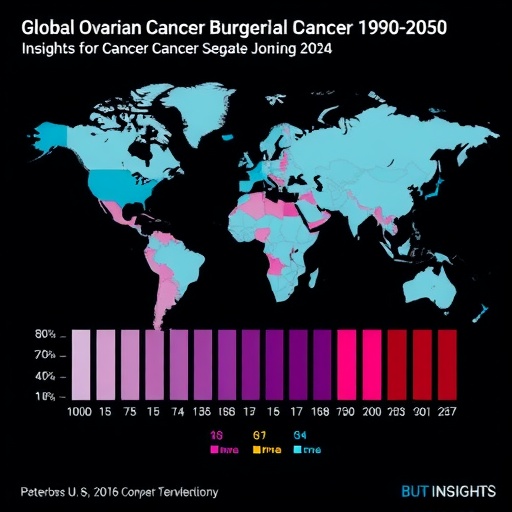Ovarian cancer remains a significant global health challenge, particularly for women aged 45 and older. Recent research published in the Journal of Cancer Research and Clinical Oncology has provided an exhaustive analysis of the burden posed by this disease from 1990 to 2021, with projections extending to 2050. The study, conducted by an international team of researchers led by Ren, Xu, and Wang, offers valuable insights into the changing landscape of ovarian cancer and magnifies the urgent need for enhanced preventive measures, treatment strategies, and support systems for affected women.
The systematic analysis is particularly notable as it is based on data from the 2021 Global Burden of Disease Study. By encompassing various metrics, including incidence, prevalence, and mortality rates, the research elucidates the stark realities of ovarian cancer on a global scale. Despite advances in medical research and treatment, the burden of this disease continues to escalate, underscoring a public health crisis that cannot be overlooked.
One of the focal points of the research is the dramatic rise in the incidence of ovarian cancer across different regions. The burden is not evenly distributed; it varies significantly between high, middle, and low-income countries. This finding prompts discussions on healthcare disparities, as women in low-resource settings are less likely to receive timely diagnoses and effective treatments. The study’s emphasis on regional variations helps in tailoring targeted health policies and resource allocation to the areas of greatest need.
The researchers have also projected the burden of ovarian cancer into the future, estimating the trends leading to 2050. This forward-looking approach is vital for health policy makers and organizations worldwide, as it provides a framework for anticipating healthcare demands and necessary infrastructure improvements. The implications of these projections are profound, indicating that if current trends continue, the number of ovarian cancer cases may increase significantly, placing even more strain on healthcare systems, particularly in developing nations.
Another key aspect of the research is the examination of risk factors associated with ovarian cancer. The findings suggest a complex interplay of genetic, hormonal, and environmental influences. Understanding these risk factors is crucial for developing effective prevention strategies. Women are encouraged to engage in regular health screenings and to be aware of their family medical history, especially if there are indications of hereditary syndromes that heighten cancer risk.
The study also highlights the importance of early detection and treatment in improving outcomes for women diagnosed with ovarian cancer. Survival rates are significantly higher when the disease is caught early, yet public awareness and screening practices remain insufficient in many regions. Raising awareness about symptoms and the need for regular gynecological check-ups are essential steps in combating the disease.
Moreover, the research panel discusses the psychological impact of ovarian cancer on affected women and their families. Beyond the physical toll, the emotional and mental burden can be profound. Comprehensive care for women diagnosed with ovarian cancer must therefore include psychological support, counseling services, and resources for family members who are also affected by the disease. Connecting women with support networks can significantly enhance their coping mechanisms and improve quality of life during and after treatment.
The research also calls attention to advancements in treatment options over the years. Targeted therapies and immunotherapies are among the latest developments that have transformed the landscape of ovarian cancer treatment. However, the study cautions that access to these advanced treatments remains inequitable, particularly in low-income countries. Advocating for uniform access to high-quality care is essential in addressing the disparities highlighted in the research.
Furthermore, the integration of technology in monitoring and managing ovarian cancer is beginning to show promise. Digital health solutions can play a pivotal role in enhancing patient engagement and adherence to treatment protocols. Using telemedicine platforms, women can receive consultations and support without geographical limitations, helping to bridge the gaps in healthcare access.
The collective findings from this comprehensive analysis serve as a clarion call for increased research funding and support for innovative solutions in ovarian cancer treatment and prevention. There is a pressing need for collaborations among governments, non-profits, and research institutions to address the multifaceted challenges posed by ovarian cancer. This collaborative approach will be essential for implementing effective strategies that can reduce the burden of the disease.
Ultimately, the continuing efforts in understanding and addressing ovarian cancer must be informed by data and rigorous analysis like that presented in this timely study. As the burden of the disease grows, the research stresses the importance of continued vigilance and proactive measures in combating ovarian cancer, aiming for a future with lower incidence and improved outcomes for women around the globe.
In conclusion, the comprehensive analysis led by Ren, Xu, and Wang is not just an overview of statistics; it is a vital call to action. The projections for 2050 highlight an impending public health challenge that necessitates immediate attention, innovative strategies, and a unified approach to change the trajectory of ovarian cancer. As we move forward, the findings of this research can inspire critical dialogues and initiatives aimed at improving outcomes for women everywhere, demonstrating that through collective action, progress is possible.
Subject of Research: Ovarian cancer burden from 1990 to 2021, projections for 2050.
Article Title: Global, regional, and national burden of ovarian cancer in women aged 45 + from 1990 to 2021 and projections for 2050: a systematic analysis based on the 2021 global burden of disease study.
Article References:
Ren, Y., Xu, R., Wang, Y. et al. Global, regional, and national burden of ovarian cancer in women aged 45 + from 1990 to 2021 and projections for 2050: a systematic analysis based on the 2021 global burden of disease study.
J Cancer Res Clin Oncol 151, 225 (2025). https://doi.org/10.1007/s00432-025-06277-9
Image Credits: AI Generated
DOI: 10.1007/s00432-025-06277-9
Keywords: Ovarian cancer, burden of disease, global health, projections, healthcare disparities, treatment strategies, early detection, psychological support, digital health solutions.




